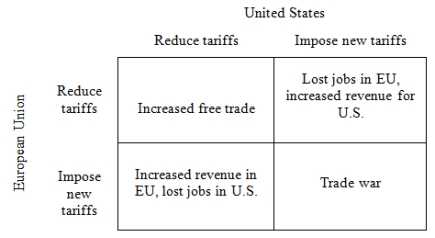Free Trade Game
Free trade occurs when goods and services between countries flow unhindered by government-imposed restrictions such as tariffs, quotas, and antidumping laws that are often designed to protect domestic industries. Although it is well known that free trade creates winners and losers, a broad consensus exists among most economists that free trade has a large and unambiguous net gain for society as a whole. For example, Robert Whaples (2006) finds in a survey of economists that "87.5% agree that the U.S. should eliminate remaining tariffs and other barriers to trade" and that "90.1% disagree with the suggestion that the U.S. should restrict employers from outsourcing work to foreign countries." Despite this consensus, it is not at all clear that countries will actually adopt policies promoting free trade.
Consider the following strategic situation in which the United States and the European Union (EU) are engaged in trade negotiations. Both countries must decide whether to reduce their tariffs or impose new tariffs. The best outcome for both countries is for them to impose new tariffs and for the other side to reduce tariffs; they could then export more easily to the other country and they would obtain increased revenue from the new tariffs. The worst outcome for both countries is for them to reduce tariffs and for the other country to increase tariffs; they would lose jobs as a result of reduced exports and the other country would benefit from their lower tariffs. Of the remaining two outcomes, both countries prefer the outcome in which they reduce tariffs to the one in which they both impose new tariffs. If both countries reduce their tariffs, then each country can benefit from increased free trade. If both countries impose new tariffs, there is a trade war in which each country sees a decline in trade and a loss of jobs. Based on this story, the preference ordering for the EU over the four possible outcomes is:
• Impose; Reduce > ; Reduce > Impose; Impose > Reduce; Impose.
And the preference ordering for the United States is:
• Reduce; Impose > Reduce; Reduce > Impose; Impose > Impose; Reduce,
where the EU's action is given first, the United States' action is given second, and ">" means "is strictly preferred to."
Using the ordinal preferences (4, 3, 2, 1) to capture these preference orderings, fill in the empty payoff matrix. Based on the preference orderings in the Free Trade Game.
Figure 1: Free Trade Game

-what is this sort of game more generally called?
Definitions:
Perception
The process of organizing, interpreting, and consciously experiencing the information from the environment through the senses.
Culture
The shared values, customs, art, and beliefs of a group of people, shaping their behavior and interactions.
Traditions
Customs, beliefs, or practices passed down through generations within a culture or community.
Character Strengths
Positive personality traits or qualities that are considered to be morally beneficial and contribute to individual fulfillment.
Q3: Which of the following are required to
Q7: Is Figure 1(a) or Figure 1(b) most
Q7: Public goods are, by their nature, desirable.
Q14: Which of the following is a television
Q15: Marketers use all of the following design
Q15: Compare and contrast the role of utilitarian
Q23: In which system(s) is the government responsible
Q32: Having problems making policy quickly, locating responsibility
Q35: Credible commitment problems are characterized by a
Q38: In which system(s) is the government responsible